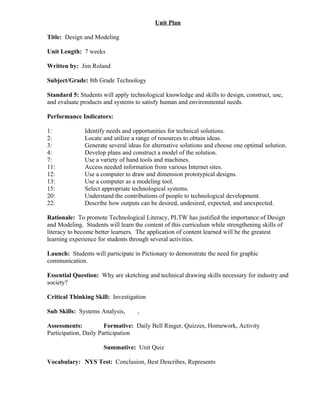
Design and modeling ii
- 1. Unit Plan Title: Design and Modeling Unit Length: 7 weeks Written by: Jim Roland Subject/Grade: 8th Grade Technology Standard 5: Students will apply technological knowledge and skills to design, construct, use, and evaluate products and systems to satisfy human and environmental needs. Performance Indicators: 1: Identify needs and opportunities for technical solutions. 2: Locate and utilize a range of resources to obtain ideas. 3: Generate several ideas for alternative solutions and choose one optimal solution. 4: Develop plans and construct a model of the solution. 7: Use a variety of hand tools and machines. 11: Access needed information from various Internet sites. 12: Use a computer to draw and dimension prototypical designs. 13: Use a computer as a modeling tool. 15: Select appropriate technological systems. 20: Understand the contributions of people to technological development. 22: Describe how outputs can be desired, undesired, expected, and unexpected. Rationale: To promote Technological Literacy, PLTW has justified the importance of Design and Modeling. Students will learn the content of this curriculum while strengthening skills of literacy to become better learners. The application of content learned will be the greatest learning experience for students through several activities. Launch: Students will participate in Pictionary to demonstrate the need for graphic communication. Essential Question: Why are sketching and technical drawing skills necessary for industry and society? Critical Thinking Skill: Investigation Sub Skills: Systems Analysis, , Assessments: Formative: Daily Bell Ringer, Quizzes, Homework, Activity Participation, Daily Participation Summative: Unit Quiz Vocabulary: NYS Test: Conclusion, Best Describes, Represents
- 2. Unit Vocab: visualization, shape, texture, design brief, isometric, orthographic, perspective, three-dimensional, performance indicator, objective, technology, pictorial, assembly, constraint, mate, flush, tangent, insert, colinear, parallel, concentric, perpendicular, angle, extrude, revolve, array, aerodynamic Guiding Questions: Predict what paper is used most to communicate an idea. Distinguish what detail is shown in an orthographic drawing compared to an isometric. Choose what file is used to create a part, assembly, drawing, etc. Predict what figure will be created if a particular shape is revolved. Discuss how parts may be assembled so that they don't crash. Adapt your design to work around the axle length. Justify whether the axle hole and air hole should intersect. Determine if your design is aerodynamic. Analyze how we will create the object you have designed. Decide if you should use the hole command or cut a circle. Student Engagement: participation in activities, observation throughout direct instruction, accountability by asking all students for answers randomly, answer individual questions, include students throughout instruction as helpers or assisting teachers, group or teamwork Meaningful Use (real world application): Students will practice graphic communication to improve their abilities to share ideas with others. Students will analyze and realize the impacts, of technology, around them have had on their lives and society. Students will practice designing and prototyping processes similar to those of many industries. Students will measure and study objects to apply information to a design developed, on the computer, before being produced. Materials/Resources: handouts, drawing manipulatives, display blocks, scissors, glue sticks, dragster examples, models to demonstrate assembly constraints How did it go?: This unit was 7 weeks long which is a bit longer than originally expected. However, to fit the given schedule, the unit flowed very well. Students struggled some with Inventor, but mostly because they were encouraged to discover the commands and program on their own and with the help of their peers. Students were very frustrated but I feel they have a greater amount of enduring knowledge for sketching and modeling. Students thought that the first sketching activity was a bit lame but soon realized how much it helped their technique. Students became very interested in the Gulf Coast oil spill when it suddenly had "impacted" their dragster design. What changes?: Next semester, I would like to implement more self-directed learning for students. This type of activity is met with great challenges but also great rewards. Next semester I may try to implement Pictionary as a review game throughout the semester. Students really enjoyed it. If not, perhaps other board games that may fit the curriculum better at that time. Lastly, I would like to incorporate more current events into student activities. Why different?: Students experienced great amounts of pride and success when they had to discover the answers on their own and I feel this should be encouraged more often. Students don't seem to have much exposure to many board games and they are great review tools. Integrating more current events will allow students to be exposed to more World news and allow them to see the impacts.